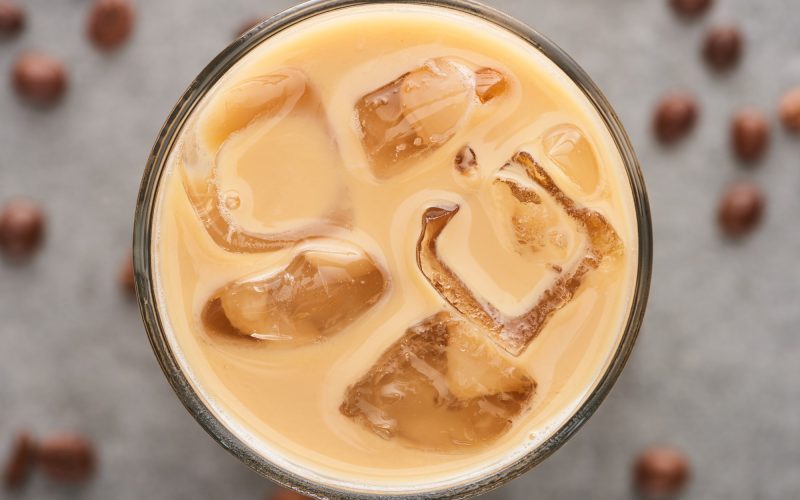As a calorie counter, you’re always on the lookout for the calorie content of different foods and beverages.
In this article, we focus on the question: how many calories are in iced coffee?
What Makes Iced Coffee Different
Unlike its hot counterpart, iced coffee contains ice, often milk or cream, and sometimes sweeteners.
These additions can significantly impact the calorie content of your drink. The calorie count can also change based on the serving size and the type of coffee used as a base.
The Basics of Counting Calories in Beverages
Counting calories in beverages follows the same principles as counting calories in food.
You need to consider the ingredients used, the portion size, and how the drink is prepared.
For example, a plain cup of black coffee contains virtually no calories.
But the calorie count increases when you add milk, cream, sugar, or flavorings to the coffee.
To get an idea of how this works, you can look at some of our other articles on calorie counting.
For example, we’ve covered how many calories in black coffee, how many calories in wine, how many calories in diet coke, and how many calories in non-alcoholic beer.
These articles provide a good foundation for understanding the basics of calorie counting in beverages.
In the following sections, we’ll take a closer look at the components of iced coffee and how they contribute to its total calorie count.
We’ll also offer tips on how to make healthier choices when it comes to iced coffee.
So, if you’re a fan of this refreshing beverage and are curious about how it fits into your diet, read on!
Understanding What’s in Your Iced Coffee
To accurately calculate how many calories are in iced coffee, you must understand the components of this refreshing beverage.
Let’s break it down.
The Role of Ice
Ice is a key ingredient in iced coffee and adds no calories to your drink. It cools down your coffee and gives it that refreshing edge, especially on hot days.
The other ingredients you add to your iced coffee contribute to the calorie count.
The Addition of Milk or Cream
Milk or cream is often added to iced coffee to create a smoother, creamier taste.
The type of dairy you choose and the amount you use will significantly impact the calorie content of your iced coffee.
For example, a tablespoon of whole milk adds around 9 calories, while the same amount of heavy cream contributes about 51 calories.
If you’re looking to cut down on calories, consider using low-fat milk, almond milk, or skipping the dairy altogether.
The Impact of Sweeteners
Sweeteners, whether they’re sugar, honey, or artificial sweeteners, can also add a significant number of calories to your iced coffee.
For instance, a teaspoon of sugar adds around 16 calories, while a teaspoon of honey contributes about 21 calories.
If you have a sweet tooth but want to keep the calorie count low, consider using zero-calorie sweeteners or natural sweeteners like stevia.
However, keep in mind that even zero-calorie sweeteners should be used in moderation.
| Sweetener Type | Calories per Teaspoon |
|---|---|
| Sugar | 16 |
| Honey | 21 |
| Zero-Calorie Artificial Sweetener | 0 |
| Stevia | 0 |
As you can see, the calorie content in your iced coffee can significantly increase depending on what you add to it.
If you are conscious about your calorie intake, consider making adjustments to your iced coffee recipe.
You can learn more about calorie counting from our article on what is calorie counting.
Calculating Calories in Iced Coffee
To effectively count the calories in your iced coffee, you need to consider each component of the drink.
This includes the coffee, dairy additions, and any sweeteners you add. Here is how you can calculate each of these aspects.
How to Estimate Calories from Coffee
Firstly, let’s address the coffee itself. The good news is that black coffee contains almost negligible calories, whether hot or cold.
On average, an 8-ounce cup of black coffee contains only 2 calories.
However, the calorie count can increase if you’re having a specialty coffee drink like a latte or cappuccino, which contains espresso, milk, and often sweeteners.
How to Factor in Dairy Additions
Adding dairy to your iced coffee can significantly increase its calorie content. As a general rule, the more fat the dairy product contains, the higher its caloric value.
For instance, one tablespoon of whole milk adds about 9 calories, while the same amount of heavy cream contributes around 52 calories.
Non-dairy options vary too, with almond milk providing about 4 calories per tablespoon and oat milk providing around 6 calories per tablespoon.
Here’s a handy table to help you estimate the caloric value of your dairy additions:
| Dairy Additions | Calories per Tablespoon |
|---|---|
| Whole Milk | 9 |
| Heavy Cream | 52 |
| Almond Milk | 4 |
| Oat Milk | 6 |
How to Account for Sweeteners
Finally, let’s talk about sweeteners, which can be the main source of calories in your iced coffee.
A teaspoon of white sugar adds about 16 calories, while a packet of artificial sweeteners typically contains fewer or no calories.
| Sweeteners | Calories per Teaspoon |
|---|---|
| White Sugar | 16 |
| Artificial Sweetener | 0 – 4 |
Remember that these are general estimates. The actual calorie count can vary based on the specific brand of dairy or sweetener you use and the amount.
Reading the nutrition label for the most accurate information is always a good idea.
Armed with this knowledge, you can make informed decisions about what to include in your iced coffee.
And remember, moderation is key! You can enjoy your iced coffee while still being mindful of your calorie intake.
For more information on calorie counting, check out our article on what is calorie counting.
Factors that Influence Calorie Content
When it comes to figuring out how many calories in iced coffee you’re consuming, several factors can influence the total count.
Let’s break it down:
Size of the Drink
The first thing to consider is the size of your iced coffee. The larger the drink, the more calories it will contain.
If you’re trying to watch your calorie intake, consider opting for a smaller size.
| Size | Approximate Calories |
|---|---|
| Small (8 oz) | 30-50 |
| Medium (16 oz) | 60-100 |
| Large (24 oz) | 90-150 |
Remember, these are approximate values and can vary based on the other factors we’ll discuss next.
Choice of Dairy
The type of dairy you add to your iced coffee can also affect the calorie count.
Options like whole milk, half and half, or cream add more calories than skim milk or non-dairy alternatives.
| Dairy Type | Calories per oz |
|---|---|
| Whole Milk | 19 |
| Skim Milk | 10 |
| Half and Half | 39 |
| Almond Milk | 4 |
For more information on the calorie content in various types of milk, check out our article on how many calories in milk.
Type and Amount of Sweetener
Lastly, the type and amount of sweetener you add to your iced coffee can significantly impact the calorie count.
Regular sugar, honey, or flavored syrups can add a significant number of calories.
On the other hand, opting for artificial sweeteners or skipping sweeteners altogether can help lower the calorie count.
| Sweetener Type | Calories per tsp |
|---|---|
| Sugar | 16 |
| Honey | 21 |
| Artificial sweetener | 0 |
For a deeper dive into the calorie content of various sweeteners, you might find our article on how many calories in sugar helpful.
By understanding these factors, you can make more informed choices about your iced coffee consumption and better manage your calorie intake.
Remember, it’s not just about how many calories in iced coffee but also about the overall balance and quality of your diet.
Making Healthier Iced Coffee Choices
Your morning iced coffee can be a refreshing start to the day, but considering how many calories are in iced coffee, it’s important to make choices that align with your health goals.
Opting for Lower Calorie Additions
When it comes to reducing the calorie count of your iced coffee, one of the most effective strategies is to opt for lower calorie additions.
For example, consider using unsweetened almond or skim milk instead of full-fat milk or cream.
These alternatives can significantly reduce the caloric content of your beverage while still providing a creamy texture.
| Addition | Calories (per 100 ml) |
|---|---|
| Full-fat Milk | 60 |
| Skim Milk | 35 |
| Unsweetened Almond Milk | 13 |
Considering Sugar-Free Sweeteners
Sweeteners can add a significant amount of calories to your iced coffee. One way to cut down on these calories is by considering sugar-free sweeteners.
Artificial sweeteners, such as aspartame or sucralose, can provide the sweetness you crave without any of the calories.
However, it’s important to note that some people may experience side effects from these sweeteners, and there is ongoing research into their long-term health impacts.
| Sweetener | Calories (per teaspoon) |
|---|---|
| Sugar | 16 |
| Aspartame | 0 |
| Sucralose | 0 |
Tips on Reducing Calorie Intake from Iced Coffee
Making a few simple modifications to your iced coffee routine can significantly reduce your calorie intake.
Here are some tips to consider:
- Skip the whipped cream: It may be tempting, but adding whipped cream to your iced coffee can add a significant amount of calories. Try skipping it entirely or opt for a light sprinkle of cinnamon or cocoa powder for flavor instead.
- Use a sugar substitute: As mentioned above, using a sugar substitute can drastically cut the number of calories in your iced coffee. Experiment with different types to find one that suits your taste.
- Choose a smaller size: It might seem obvious, but choosing a smaller size can be an easy way to cut calories. If you’re used to ordering a large, try going for a medium or small instead.
- Brew your own: Making your iced coffee at home gives you complete control over what goes into your drink. This means you can adjust the amount of milk, cream, sugar, and other additions to fit your dietary needs.
These simple changes allow you to enjoy your iced coffee without worrying too much about the calorie count.
For more on calorie counting, check out our article on what is calorie counting. Enjoy your healthier iced coffee!








